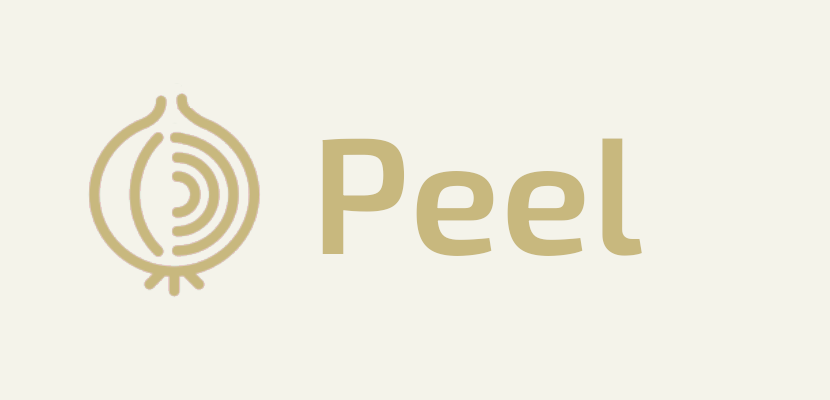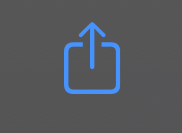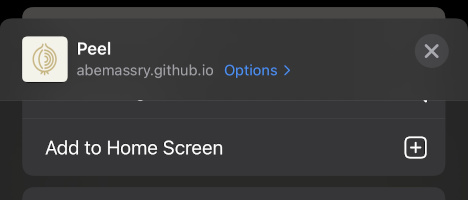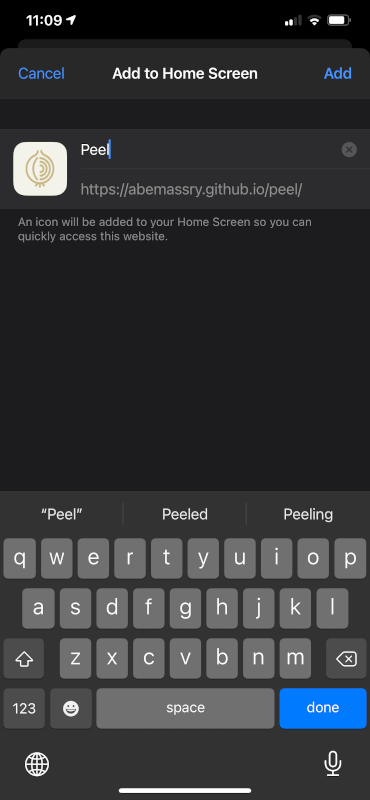Peer to Peer Distributed Serverless Social Network in browser
- A modern browser (e.g. Chrome v92+, Firefox v91+, Safari v14.1+)
- Be a nice person, in all aspects while using this webapp
https://abemassry.github.io/peel
Peel is a mobile first webapp that can be installed to a mobile device to appear to behave like a native app. Here are the installation instructions. These are screenshots of iOS, Android should be very similar
Tap the share icon
Tap add to home screen
Tap Add in the upper right hand corner
It's installed!
Peel is a peer to peer, distributed, serverless, social network that operates entirely in a browser.
"Main Feed" view
You can create a User
Make a post
All communication is browser to browser
The main feed is persistent via Local Storage
You can also send direct messages
And make phone calls
Direct Messages are not persistent and not logged anywhere, they only exist between two browsers
Phone calls are not recorded they are only an audio connection between two browsers
The entire app is in one HTML file, I wanted to start small and grow from there but like a lot of projects when I started working on it the scope blew up. So in the future the code might be broken up into multiple files and there may or maynot be a build process.
The CSS framework is Bootstrap, the JavaScript framework is Vanilla.js.
The project might choose a different JavaScript framework in the future.
The app in general was coded mobile first and desktop secondary.
The peel network exists as a shared state in between all of the browsers participating in the network. State is persistent via Local Storage.
The state is communicated to the other nodes in the network whenever a change is made. One node is connected to another node and mutual connection is possible, but it is also possible for a non mutual connection to be made. This is how we avoid the many to many problem. Each node can connect to a different node like a linked list and forward the message along.
In addition one node can be a hub by adding symmetric connections, meaning if a node already has a peer, but an additional node wants to connect the first node adds an additional connection and it starts acting like a hub and fans out messages to it's main connection as well as it's symmetrical connections.
When one to one connections are possible in addition to one to many all participating in the same network there is less of a chance of "network islands" to appear. Meaning the app still looks like it's functioning correctly but all participants are not connected to each other, one group might section off. If a hub appears there is less of a likelihood of this happening because one node can act as a bridge in this situation.
In the discovery phase a counter is incremented and the next available ID is tried, if successful the ID becomes the ID of that node and the user is then associated with that ID for the lifetime of the current browser session. Once an ID is found, IDs are then cycled to try to find a peer participating in the same network. If a peer is found a connection is made and the originating peer polls the connection for any new messages.
If a new message is sent the receiver must forward the message along. In order to avoid infinite positive feedback loops many checks are made to determine if the message should be forwarded along.
- Who is the originator of the message?
- Who is the sender of the message?
- Should this message be fanned out to the symmetric connections?
WebRTC is the communication protocol that is used and the connections are set up using peerjs.
Once a direct message is requested since the node IDs have been shared with all members participating in the network a direct message can be sent to a peer. Upon sending a direct message an additional WebRTC connection is made between the two browsers and a phone call can be initiated by either browser over WebRTC.
The future tasks are listed in the ToDo section of the project page for this repo ToDos
Longer term goals include:
- Video Calls
- Peer to Peer binary transfer
- Choosing what kind a feed to see based on a follower mechanism
- Address Book or Recently Contacted list
- Native App that participates in the WebRTC network
- Group audio calls
- Video Broadcasting
- Larger scale JavaScript framework
If you'd like to support this project:
Sign up for an account at I Read This Week
Purchase an account at wsend
I also have a videogame for sale Rain Drop
As well as the soundtrack album to go with it Rain Drop (Original Video Game Soundtrack)
When I'm not on Peel, I'm also on Twitter @abemassry, say hi sometime.








